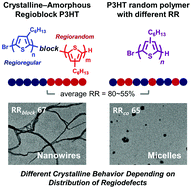Herein, we report the development of poly(3-hexylthiophene) regioblock copolymers (block-P3HTs), which are composed entirely of identical 3-hexylthiophene repeating units, with one block being highly regioregular (rre) and the second block being regiorandom (rra). This block-P3HT was prepared via catalyst-transfer polycondensation by the sequential addition of different monomer batches, with 3-hexylthiophene (3HT) monomers used for the rre block and a mixture of 3HT and 3,3′-dihexyl-2,2′-bithiophene (BT) monomers for the rra block. The average regioregularity (RRavg) of the block-P3HTs was tuned from 58 to 79% by differentiating the weight ratio between the rre and rra blocks, and the crystalline behavior of block-P3HTs in comparison with polymers having similar RRavg but a random distribution of 3HT and BT units (co-P3HT) was investigated. This study allowed for the exploration of the effects of the distribution of regiodefects within the polymer chain (e.g. confined to a single block versus uniformly distributed throughout the polymer) on the crystalline behaviors of the polymer. For example, block-P3HT with 72% RRavg formed long nanowires by solution assembly, due to the strong crystallinity from a sufficient effective conjugation length in the rre block, whereas co-P3HT with the same RRavg formed spherical micelles indicating amorphous characteristics. Overall, the block-P3HTs showed a strong tendency to crystallize, even with very low RRavg, driven by the rre block in the polymers, whereas the crystallinity of the co-P3HTs was substantially suppressed due to chain distortion by the distributed regiodefects.
